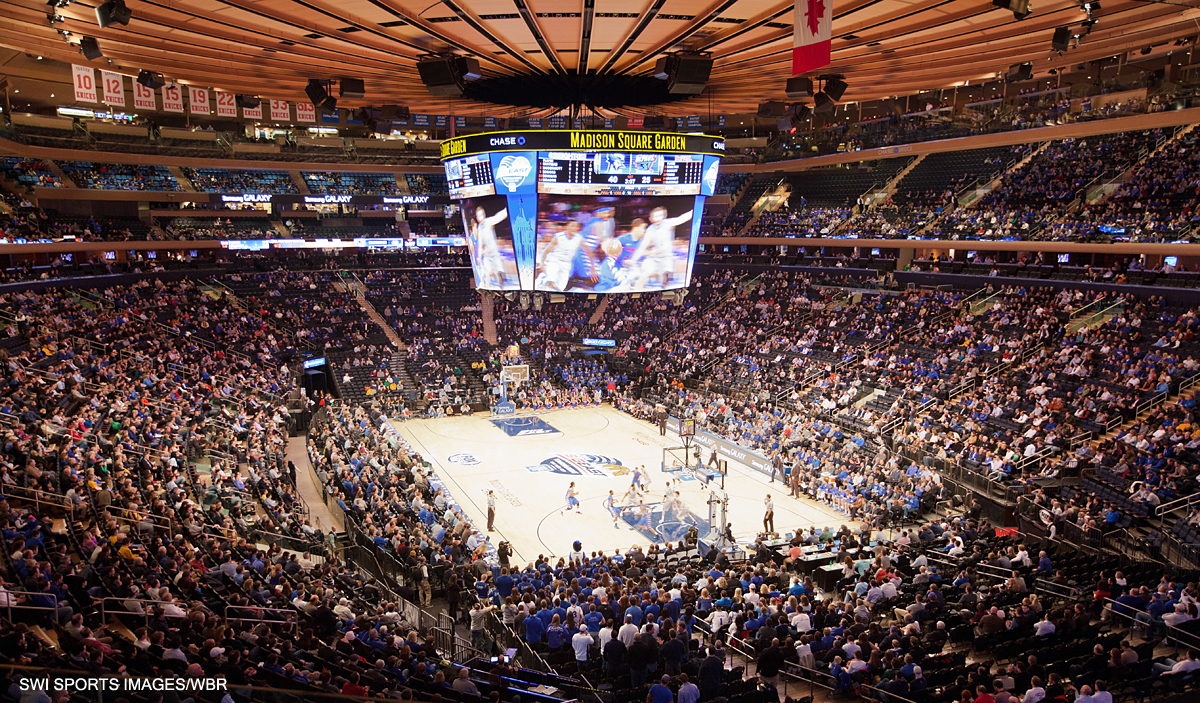With yesterday’s announcement at Madison Square Garden in NYC, it’s official: the University of Connecticut is joining the Big East (or, rather, rejoining the Big East). The story is being framed both around the league and nationally as a basketball story, and with good reason: the Big East is the only power conference in the country where basketball is the primary focus, instead of football.
Viewed through that lens, welcoming UConn back is a no-brainer. The men’s basketball team has won four national championships, and despite a recent downturn, remains a national brand name in college hoops. They’ve won the Big East tournament more times (8) than anyone else. They’re a charter member of the league and have long-standing rivalries with the four remaining members of the Big East’s Original Seven (Georgetown, Providence, St. John’s, and Seton Hall) plus Villanova, who joined a year later.
With UConn in the fold, the “Classic Big East” of the 1980s that so many (*cough* ESPN *cough*) left for dead is now nearly intact — only Boston College, Syracuse, and Pitt are missing from the pre-1991 version of the league. And with a 20-game round-robin schedule, those original teams will play each other more often in the modern day Big East than they did in the bloated 16-team version. It’s true: in 2013, the last year before the Big East/AAC split, Connecticut played eight regular season games against the “Classic” Big East. They’ll play a minimum of 10 such games in their first year back in the league in 2021.
Viewed through more cynical lenses, the addition of UConn is less of a no-brainer. The current Big East, comprised of 10 private universities based in big-slash-medium cities, is now joined by a large state university in a college town with nearly 10,000 more students than the next closest member of the league. And they’re not giving up on big time football, at least not right away: they will continue playing FBS football as an independent. The Big East shares that last concern — so much so that they wrote their concern into the contract. It states that UConn’s football program “could, as it has in the past, create a misalignment of interest with other members.”
To that end, the Big East has negotiated a much larger than normal exit fee into the contract: $30 million if they leave in the first six years of the agreement, which is three times their exit fee from the AAC and TEN TIMES the amount of their entry fee. The exit fee gradually decreases the longer they’re a member of the league, and while it’s not such a large amount of cash to make it insurmountable, $30 million is a punitive amount no matter who you are. The biggest takeaway, for me, though? Once the exit fee drops to $10 million in Year 11, it still remains larger than the exit fee for any of the other 10 members.
Here’s the actual contract language:
Commissioner Val Ackerman and the leadership of the Big East can’t completely insulate the other 10 members from the pull of FBS football at UConn, but they’ve done everything they can to protect the league contractually. If the unlikely, but possible, scenario happens where the ACC or Big XII invite UConn to join, the members of the Big East will at least receive a windfall of cash.
And according to the Hartford Courant they also included language in the contract that prevents UConn from parking their football program in a Power 5 football conference while competing in the Big East in all other sports. Again, that’s an unlikely scenario, but including it in the contract shows how thorough Ackerman and the league’s brass were in developing the agreement.
Most media coverage of UConn returning to the league has focused on the basketball impact, and rightfully so, but their addition to the league will affect Creighton in other sports, too — some good, some bad. Let’s take a sport-by-sport look, starting, of course, with hoops.
Men’s Basketball
Former Rhode Island coach Dan Hurley will be entering his third year as head coach when UConn returns to the Big East in 2021; as he begins his second season this fall, he welcomes a Top 20 recruiting class that they hope builds a foundation for their return to national prominence.
Creighton and UConn generally aren’t recruiting the same areas of the country, so their addition affects CU mostly on the court. If and when UConn returns to prominence, it adds another splashy brand name to the league’s marquee and another big game to Creighton’s home schedule. Those are decidedly great things.
For other programs around the league, it affects them more directly. Longtime Providence beat writer Kevin McNamara wrote in the Providence Journal this week that the move helps the league in general but hurts Providence, Seton Hall and St. John’s — three programs separated from UConn by less than 150 miles, often battling for the same recruits. An excerpt from his excellent analysis:
With UConn stuck in nowhere’s land, once-struggling Big East programs like Providence and Seton Hall have thrived. Both have made repeated NCAA Tournament appearances, the Friars an unprecedented five straight seasons (2014-18). Is there a direct connection between this success and UConn’s fall?
“They had one foot in the grave,” said one Big East insider. “Now we’re saving them.”
Schedule-wise, the addition of UConn means that the league will now play 20 conference games. Combined with the Gavitt Games, the Big East/Big 12 challenge, the Nebraska game, and a holiday tournament, as many as 26 of their 31 games will be pre-determined some (if not most) years.
It also means the Big East Tournament will follow the bracket model used by the Big Ten during their years as an eleven-team league. The top five teams get a “bye” to the quarterfinals on Thursday, while the bottom six square off on the first day of the tourney. For a league as fiercely competitive as the Big East where there frequently isn’t much difference between the teams seeded in the middle, that’s a huge shift. One fewer bye, and only the top three seeds get to play a team who won the day before — the 4 and 5 seeds will play each other in the quarterfinals.
Women’s Basketball
The UConn women’s basketball team is the most storied in the sport, with 11 national titles, 20 Final Fours and 40 conference regular season or tournament titles. When they departed for the AAC in 2013, Geno Auriemma was quoted as saying they were in a league of their own, and it wasn’t just bluster. In women’s college basketball there’s UConn and there’s everyone else.
In six seasons in the AAC, they’ve never lost a game — going a perfect 120-0 — and have reached the Final Four all six seasons, winning three titles. Jim Flanery’s team might not win another Big East title anytime soon once Geno’s Huskies are in the league, but they’ll get to measure themselves against the best in the sport twice a year. The league’s overall pedigree will be raised, individual RPI will be boosted, and programs will get to use “playing against UConn twice a year” in recruiting pitches. It’s no wonder Flanery told the Omaha World-Herald’s Jon Nyatawa that his program is in position to gain as much as anyone at Creighton with this move.
FOX executives, too, have to be positively giddy at the prospect of televising UConn women’s games on FS1 or network FOX. They’re a ratings juggernaut, especially in the northeast (their games on SNY routinely outrate Red Sox, Bruins, and NFL Thursday Night Football games in the Hartford/New Haven DMA). That means we’re likely to see more women’s games on cable or network than we’ve seen in the past, which is good for the league.
Fun fact: Creighton and UConn have met once in women’s basketball, with the #1 UConn women winning 96-60 in 2014. That win started their NCAA record 111-game winning streak, which extended to the 2017 Final Four when they lost on a buzzer-beater to Mississippi State.
Baseball
In baseball, the Big East adds a program who has made three of the last four NCAA Tournaments (and six of the last ten), including at-large bids in 2018 and 2019. Under veteran coach Jim Penders, they also advanced to a Super Regional in 2011. UConn baseball is the premier college program in the northeast, with 47 players drafted by MLB clubs during Penders’ 15-year tenure.
The Huskies are set to move into a sparkling new ballpark next spring that will instantly rank among the league’s best (a low bar, admittedly) and should join Creighton and Xavier among the top echelon of the league’s baseball programs immediately.
The addition of another NCAA Tournament caliber program will enhance the league’s profile nationally. With eight league schools now playing the sport, the league’s regular season schedule will increase to 21 games, and revamping the conference tournament format to include six teams instead of four should be on the table.
Soccer
The same can be said for both men’s and women’s soccer. A storied program with three national titles, the men’s most recent title came at the expense of Creighton — they beat the Jays 2-0 in the 2000 title game. They led the nation in average attendance last season with 3,213 fans per game, and will give Morrison Stadium competition for the title of best soccer environment in the league. Adding a program that has made 18 of the last 21 NCAA Tournaments is good.
On the women’s side, UConn is a frequent NCAA Tournament participant who has advanced to six College Cups and finished as the runner-up four times. Both programs add an elite pedigree to an already solid soccer conference.
Volleyball
The same can not be said for Volleyball. The Huskies have had two winning seasons since 2012 — and went 16-15 both years. Most seasons, they’re a middling program that hovers below .500. Unless their fortunes turn around, the addition of UConn will make it more challenging for elite programs like Creighton and Marquette to build resumes worthy of hosting NCAA Tournament matches. Why? Because it will probably be tempting for the Big East to simply play the same double-round-robin 20 match slate they do in men’s and women’s basketball.
For CU volleyball, playing 20 Big East matches takes away two scheduling slots they would otherwise use to play top-tier non-conference opponents.
It might be tempting, but thankfully it’s not a given that the league moves to a 20-match double-round robin slate in volleyball. The Pac12 and B1G are the only leagues who play 20, but they make up for it by not holding a conference tournament. It would seem there are two options: keep a double-round robin and eliminate the conference tourney, or stick with an 18-match schedule and keep the conference tourney. Moving to 20 and keeping the tourney should not be an option.


